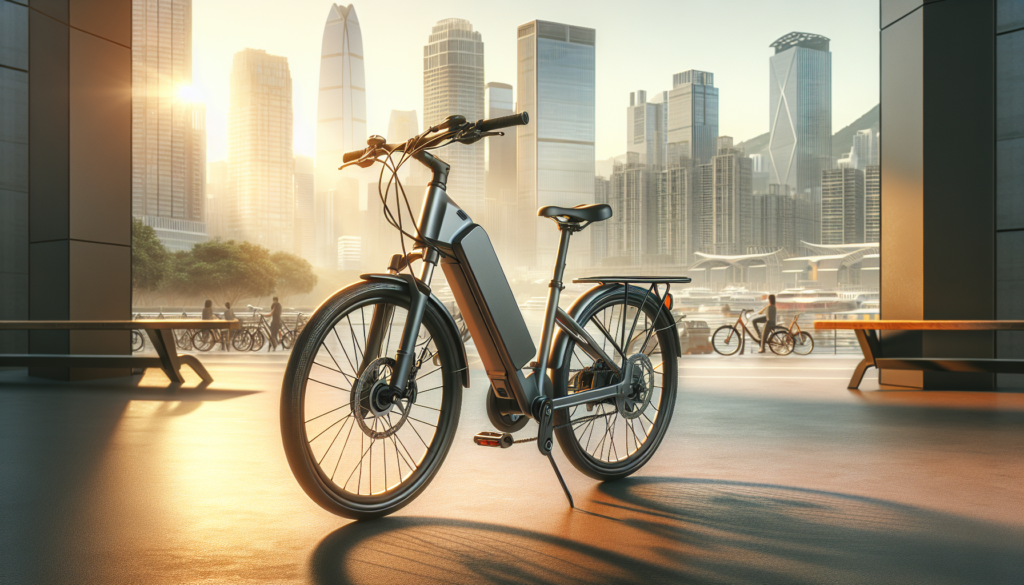
In the realm of electric bikes, the ADO A20 Lite has emerged as a formidable competitor against the Xiaomi Ebike Himo Z20. With its advanced technology and thoughtful design, the ADO A20 Lite from EKO Life MY offers riders a unique blend of performance and affordability, making it a standout choice for both casual cyclists and avid riders alike. Featuring three distinct electrical assist modes and a lighter frame, this e-bike excels in both efficiency and versatility. As we delve deeper into the specifics of these two models, you will discover why the ADO A20 Lite might just be the perfect match for your biking needs.
Overview of ADO A20 Lite Features
The ADO A20 Lite is a remarkable electric bike that stands out with its three distinct electrical assist modes, providing riders with various options for their journey. This feature allows users to customize their riding experience based on their needs, whether they’re looking for a leisurely commute or a more vigorous ride. Additionally, equipped with a 36V 9.6Ah lithium-ion battery, the ADO A20 Lite boasts a remarkable range of approximately 60 km, ensuring that riders can go the distance without worrying about running out of power. Weighing just 16 kg, it also offers a lightweight feel, making it easier to maneuver and transport than its competitors, such as the Xiaomi Ebike Himo Z20.
Furthermore, the ADO A20 Lite features a smooth belt system that provides a quieter and more efficient ride compared to the chain system on the Himo Z20. This design not only enhances performance but also reduces maintenance needs, giving riders an advantage in terms of convenience and longevity. Moreover, the mechanical disc brakes on the ADO A20 Lite provide superior stopping power, ensuring safety in various riding conditions. With a maximum load capacity of 100 kg, it is robust enough to carry additional cargo or a rider of greater stature.
The price point of RM 3,699 may seem higher than the Xiaomi Ebike Himo Z20 at RM 3,099, but the additional features and superior performance of the ADO A20 Lite justify the investment. Ultimately, riders looking for flexibility and ease in their e-bike experience will find the ADO A20 Lite to be a superior choice.
Comparative Analysis: Battery Performance
When it comes to battery performance, the ADO A20 Lite distinctly stands out against the Xiaomi Ebike Himo Z20. Both e-bikes are equipped with 36V lithium-ion batteries, offering a range of approximately 60 km. However, what sets the ADO A20 Lite apart is its slightly more efficient 9.6Ah battery. This efficiency not only supports a range that rivals the Himo Z20 but also enables lighter weight and easier handling, thanks to its total weight of only 16 kg compared to the 21.6 kg of the Xiaomi Ebike. This makes the ADO A20 Lite a more versatile option for urban commuting, especially for those who prioritize maneuverability and ease of use in congested city environments.
Moreover, the ADO A20 Lite features three electrical assist modes, allowing users to choose the level of assistance they desire based on their riding conditions. In comparison, the Xiaomi Ebike Himo Z20 provides just two modes. This additional functionality means that riders of the ADO A20 Lite can fine-tune their experience, resulting in better battery efficiency and personalized control over their ride. With this thoughtful design, the ADO A20 Lite not only enhances the overall riding experience but also puts forward a compelling case for those seeking superior battery performance in their electric bikes.
Weight Considerations: ADO A20 Lite’s Advantage
When comparing the ADO A20 Lite and the Xiaomi Ebike Himo Z20, weight plays a crucial role in determining the practicality and versatility of an electric bike. The ADO A20 Lite weighs in at just 16kg, making it significantly lighter than the Xiaomi Ebike, which weighs 21.6kg. This notable difference in weight can greatly influence portability, especially for users who need to carry their bikes up stairs, store them in compact spaces, or transport them via public transport. The lightweight design of the ADO A20 Lite allows for easier handling and maneuverability, which can enhance the overall riding experience for users navigating through crowded places or varied terrains.
Additionally, lighter bikes are often easier to accelerate, allowing riders to reach their desired speeds more quickly and efficiently without extra physical effort. The ADO A20 Lite‘s weight advantage also extends to its construction, as the bike utilizes a belt system that contributes to its lightweight nature. In contrast, the Xiaomi Ebike Himo Z20’s chain system can add extra weight and maintenance needs, which can detract from the user experience.
With the ADO A20 Lite, riders not only enjoy a decent range of about 60km on a 36V 9.6Ah Li-ion battery but they also benefit from a design that prioritizes ease of use and agility. This makes the ADO A20 Lite a compelling choice for riders who prioritize lightweight options in their electric biking adventures.
Electrical Assist Modes: Why ADO A20 Lite Wins
When it comes to electrical assist modes, the ADO A20 Lite clearly takes the lead over the Xiaomi Ebike Himo Z20. The ADO A20 Lite features three distinct assist modes, allowing riders to customize their experience according to their needs, whether they want an energetic ride, a balanced ride, or a more relaxed approach. With each mode designed to suit different cycling situations, it offers better adaptability for various terrains and rider preferences.
On the other hand, the Xiaomi Ebike provides only two modes, Dynamic Sports Mode or Cool Mode, which may limit its versatility for some users seeking a tailored riding experience. This additional assist mode in the ADO A20 Lite not only enhances control over the bicycle’s power output but also maximizes efficiency during longer rides. Moreover, both bicycles are equipped with similar 36V batteries that offer a commendable range of about 60km. However, it’s the added electrical assist options in the ADO A20 Lite that allow for a more fluid relationship between the rider and the bike.
This adaptability can elevate the overall riding experience, making the ADO A20 Lite the preferred choice for those who value flexibility and performance in their electric bike ride. Riders seeking comfort and adaptability will undoubtedly find the ADO A20 Lite‘s three electrical assist modes more beneficial compared to the reduced options of the Xiaomi Ebike.
Comparison of Build and Design: Belt vs. Chain System

When comparing the build and design of the ADO A20 Lite and the Xiaomi Ebike Himo Z20, one key difference stands out: the drive system—belt versus chain. The ADO A20 Lite features a belt system, which typically delivers a quieter and smoother ride, requiring less maintenance over time due to reduced wear and tear.
Belt systems are also known for their lightweight design, contributing to the ADO A20 Lite‘s overall weight of just 16kg, making it easy to handle and ride. Furthermore, the ADO A20 Lite’s frame is designed to be sleek and stylish, enhancing its aesthetic appeal while ensuring a sturdy construction for support up to 100kg. In contrast, the Xiaomi Ebike Himo Z20 uses a traditional chain system.
While chains are common and can handle significant loads, they do require more frequent maintenance and can produce more noise during operation, potentially detracting from the overall ride experience. Additionally, the weight difference is palpable with the Xiaomi Ebike Himo Z20 weighing 21.6kg, which may make carrying it or maneuvering more cumbersome for some riders. Hence, the ADO A20 Lite not only stands out with its efficient belt system but also in its lightweight design, making it an attractive option for those looking for comfort and ease of use in an electric bike. Overall, the ADO A20 Lite’s design elements enhance its performance and practicality, making it a superior choice compared to the Xiaomi Ebike Himo Z20.
Pricing Perspectives: Value for Money
When comparing the pricing of the ADO A20 Lite with the Xiaomi Ebike Himo Z20, the ADO A20 Lite emerges as the more reasonable choice for those seeking value for money. Priced at RM 3,699, it offers three electrical assist modes, making it versatile for various riding conditions. In contrast, the Xiaomi Ebike Himo Z20, while slightly cheaper at RM 3,099, only provides two assist modes. The additional mode on the ADO A20 Lite can significantly enhance the riding experience, allowing users to adapt according to their needs and preferences. The investment in the ADO A20 Lite ultimately provides greater flexibility, justifying the marginal increase in price.
Moreover, both bikes share a similar range of approximately 60 km thanks to their powerful batteries—36V 9.6Ah for the ADO A20 Lite and 36V 10Ah for the Xiaomi Ebike. However, the ADO A20 Lite is 5.6 kg lighter, making it easier to maneuver and carry if needed. This further enhances its value proposition, especially for riders who prioritize portability without compromising performance. Overall, with its additional features and lighter design, the ADO A20 Lite stands out as a superior option in terms of value for money compared to the Xiaomi Ebike.
Loading Capacity: Both Bikes in Perspective
When evaluating loading capacity, both the ADO A20 Lite and the Xiaomi Ebike Himo Z20 boast a maximum load of 100kg. However, the ADO A20 Lite comes out on top in other aspects that enhance its overall usability. Weighing only 16kg, it is significantly lighter than the Himo Z20, which weighs in at 21.6kg. This reduced weight not only makes the ADO A20 Lite easier to handle but also improves its portability and transportability, allowing users to effortlessly maneuver the bike or lift it when needed. The belt system on the ADO A20 Lite also contributes to this weight advantage, providing a smoother ride with less maintenance compared to the chain system found on the Himo Z20.
In addition to its lighter weight, the ADO A20 Lite features three electrical assist modes, giving riders more options to customize their riding experience based on their needs. This capability stands in contrast to the Xiaomi Ebike Himo Z20’s dual electrical assist mode. Users can choose from multiple settings on the ADO A20 Lite for optimal performance, making it a more versatile option for various riding conditions. Combining these advantages with its competitive pricing of RM 3,699, the ADO A20 Lite offers better overall value for those looking for a reliable yet lightweight e-bike option.
User Experience: Handling and Riding Comfort
When it comes to user experience, the ADO A20 Lite excels in handling and riding comfort. Weighing in at just 16kg, the A20 Lite is significantly lighter than the Xiaomi Ebike Himo Z20, which weighs 21.6kg. This lower weight enhances the bike’s maneuverability, making it much easier for riders to navigate through urban environments or tight spaces. The belt system on the ADO also minimizes mechanical vibrations, contributing to a smoother ride, while the mechanical disc brakes ensure reliable stopping power. Riders will appreciate the nimble handling and control, which are crucial for both casual rides and more intense commuting scenarios.
Additionally, the ADO A20 Lite offers three electrical assist modes, allowing users to customize their riding experience to match their comfort level and terrain more effectively than the dual modes of the Xiaomi Ebike. The comfort doesn’t stop with handling; the ADO A20 Lite is designed with the rider in mind, making it an appealing option for daily use. By offering a range of riding modes and a lightweight design, it encourages a more enjoyable experience on longer rides. Riders can easily tackle distances of about 60km on its 36V 9.6Ah Li-ion battery without feeling fatigued.
In comparison, while the Xiaomi Ebike also offers a commendable range and decent features, the ADO A20 Lite‘s user-centric design provides an edge in riding comfort that is hard to overlook. Whether you’re commuting to work or enjoying a leisurely weekend ride, the ADO A20 Lite‘s thoughtful engineering caters to the needs of the modern cyclist.
Final Thoughts: ADO A20 Lite Takes the Lead

In the ultimate showdown between the ADO A20 Lite and the Xiaomi Ebike Himo Z20, the ADO A20 Lite clearly holds several advantages that make it a better choice for riders. With its lighter weight of 16kg, compared to the 21.6kg of the Himo Z20, the A20 Lite offers better maneuverability and ease of transport. Additionally, the belt system provides a smoother and more efficient ride, while retaining a maximum load capacity of 100kg, making it suitable for a variety of riders. With a competitive price of RM 3,699, it represents a fantastic value for those looking for an efficient and user-friendly electric bike without breaking the bank.
Moreover, the ADO A20 Lite boasts multiple assist modes that allow riders to tailor their experience to their preferences, ensuring a comfortable ride for all situations. While both bikes feature a similar battery range of about 60km, the slight differences in specifications and pricing give the ADO A20 Lite an edge over the Xiaomi Ebike Himo Z20. Overall, if you’re in the market for an electric bike that combines performance, versatility, and affordability, the ADO A20 Lite stands out as the superior choice.

I’m looking forward to a detailed article about the topic
Thank you for your interest, Calvin! We’re working on creating an in-depth article about the topic and will notify you as soon as it’s published. In the meantime, you can explore other articles on our blog or feel free to contact us at [email protected] or +60 3-7890 3042 for more information.
What exactly is the main point this blog wants to convey?
Hello Sharon Tan, thank you for taking the time to read our blog. Our main point is to empower bicycle, ebike, and escooter enthusiasts in Malaysia through affordability, quality products, and professional servicing. We aim to create a supportive community for like-minded individuals. If you’d like to know more, please feel free to contact us at [email protected] or call us at +60 3-7890 3042.
I think this blog might need more attention to clarity and editing, but I’m eager to read the rest
Hello Zhuang, thank you for your honest feedback! We appreciate your willingness to read the rest of our blog. Clarity and editing are essential for us, and we’ll take your suggestion into consideration. If you have any specific suggestions or ideas on how we can improve, feel free to share them with us at [email protected] or call us at +60 3-7890 3042. Your input is valuable to us!